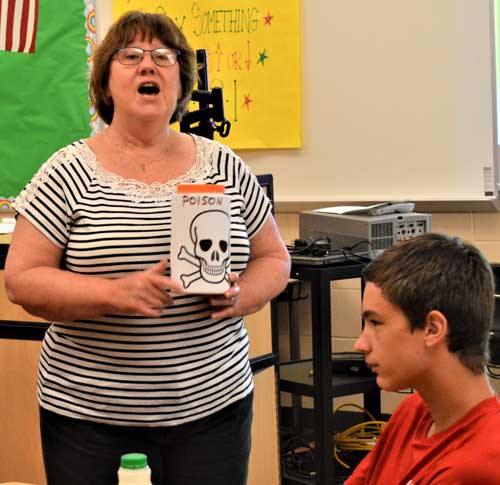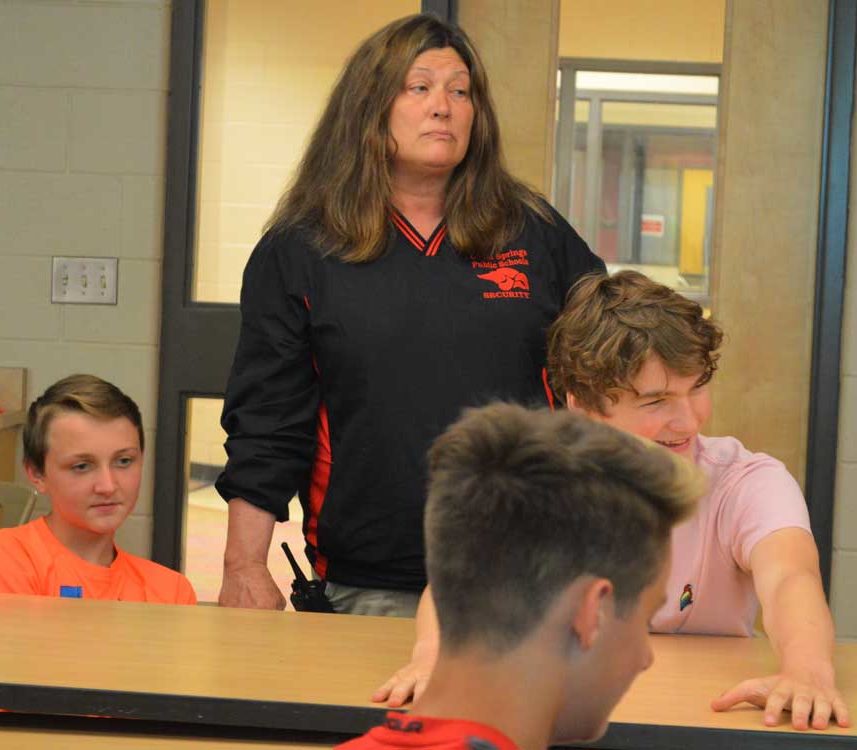The use of electronic cigarettes — called vaping — is being touted by young people as safer than smoking, said Sherie Kopenski, school safety and security officer.
“We don’t know where they are getting their information, but we do know it is more discreet (than smoking),” Kopenski said. “And we find kids doing it on the buses, in restrooms and even in the classroom.”
Hoping to help students understand the risks of using e-cigarettes, the district has stepped up efforts to get information to them about the health risks.
Vaping is the act of inhaling and exhaling the aerosol, or vapor, produced by a device that usually contains nicotine, flavorings and other chemicals. Battery-operated devices used for vaping resemble cigarettes, cigars or pipes, but also everyday items such as pens or USB memory sticks. The heating device vaporizes the liquid in the cartridge so the user can inhale.
Kopenski, who has worked in the district for 10 years — eight at the middle school — said this past school year was “the worst year for finding kids smoking and vaping. We even had one marijuana incident,” she said. “And kids tell me they are using.”
Vaping was added to school guidelines as a prohibited behavior about five years ago, and brings the same penalties as smoking. In addition to automatic suspension for use on school grounds, offenders are required to attend lunchtime presentations on vaping, presented by Cherry Health.
The school is poised next year to do more school-wide education.
“We are hoping to help students understand what vaping is, and what it can do to their bodies,” said Principal Sue Spahr.

Risky Behavior
Students may believe vaping is safer than smoking, but there have not been enough studies to show that, said Sharon Briggs, prevention specialist at Cherry Health.
Health risks are similar to tobacco and include high blood pressure, heart attack and stroke, she said.
According to the National Institute on Drug Abuse: “Young people who use nicotine products in any form, including e-cigarettes, are uniquely at risk for long-lasting effects.”
Briggs agreed. “The bottom line for you is that it is not safe — especially for young people, especially since your brains are still developing. It is important that you give your younger brains a chance to grow.”
She added that Juul, a brand commonly used by young people, often has a much higher concentration of nicotine than a traditional cigarette.
“A young person can become addicted after just one or two puffs,” Briggs said.

Going Incognito
The devices that people use to vape has contributed to the problem. Juul is sold in pods that fit into devices nearly unrecognizable to non-users.
“What has happened, and happened rather quickly, is that they don’t look the same as when e-cigarettes came out,” said Briggs. “In fact, many look much like a flash drive and they can even be plugged into their school computers to charge the batteries.”
Students who attended a late-year presentation were there by choice, parent request, or were required to because they had been suspended for substance use on campus.
Some of them were willing to share their experiences about how easy they are to use at school.
“I had a friend who was doing it on the bus coming home from a wrestling meet,” said eighth-grader Logan Harris. “I didn’t get caught doing it at school, but I got caught selling a bottle of juice.”
“My friends and I were doing it in the bathroom,” said eighth-grader Alexis Rooks.
“I’m here because my brother vapes, and my mom is afraid that I will start too,” said Logan Williams. “Vaping is a bad decision, but it is one nearly everyone makes.”

Habit-forming
School officials say they know that some students are exposed to the products at young ages, drawn by flavors such as blue raspberry and cotton candy.
“Some kids have told me that they have been using since they were 9 and 10 years old,” said Kopenski.
Chaise Schumacher said she first tried vaping when her younger sister and her friends brought it into the house.
“I know lots of fifth- and sixth-graders are doing it too,” said Logan Harris.
The district’s goal: to be more proactive. “One thing I know from being in the high school is that, by then, they are either doing it or not doing it,” Kopenski said. “They are already set in their ways.”
Students had mixed reactions to the presentation, ranging from snickers and eye-rolling to solemn nods.
In Alexis’ opinion, “these kinds of things and assemblies really don’t help anything. We also hear a lot about bullying, but it still goes on.”
But Chaise took away a few things to think about.
“I thought it was interesting that (Briggs) said (buying vape liquid) was like buying a bottle of poison,” she said. “And I really didn’t know that they were targeting kids our age and younger.”
CONNECT
New school-based health clinic serves Cedar Springs students









